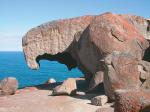Our new research site - all 440,000 hectares of it!
The whole of Kangaroo Island has become a major new ecological research site, with the University of Adelaide leading the way. The Kangaroo Island Long-Term Ecological Research Site (or KI LTER) is a joint project between the university and other key institutional and government partners, and is believed to be the biggest of its type in the world. The fifth Long-Term Ecological Research Site in Australia, it encompasses all of Kangaroo Island's 440,000 hectares, as well as nearby islands and seaways. By comparison, probably Australia's best-known LTER - the Warra LTER in Tasmania - is about 15,000ha, and no other LTER worldwide is believed to cover anywhere near the same amount of area.
Coordinator of the KI LTER and University of Adelaide lecturer in Plant and Pest Science Dr John Jennings says Kangaroo Island was chosen because of its relative isolation and unique environment. "What we are trying to do with the Kangaroo Island LTER is understand what has happened ecologically across the island over time, which helps us to better plan for the future," Dr Jennings said. "KI is a unique location, and importantly for us it is unique even in the context of the Australian environment. "It has been isolated from the mainland for some 10,000 years and has not suffered vegetation clearance to the same extent as the mainland. It has not had the same association with Aboriginals and fire that the mainland has, and it has avoided some of the major environmental pests on the mainland like the rabbit and the fox. "The island represents a fantastic opportunity for the LTER partners to learn more about the Australian environment, focusing on such areas as dryland salinity, biodiversity, the impact of tourism, fire management, and looking after threatened species like the Sooty Dunnart and the Glossy Black Cockatoo. "With its links to a network of national and international LTER sites, the KI LTER will be a vehicle to promote and coordinate ecological research on the island. "We will also have a strong focus on education, with a focal point being the new Flinders-Baudin Research Centre set up by David Paton from the University of Adelaide." In launching the project, Environment and Conservation Minister Mr John Hill said it was a extremely valuable project for Kangaroo Island and South Australia. "The data that will be collected through the study will help us understand the island's ecological history - but also assist better planning in the future," he said. "Kangaroo Island is regarded as being unique as it was untouched for so long and is isolated, so it makes a ideal location for this project. "I look forward to watching progress with this exciting and innovative program." The LTER partners are: the University of Adelaide, Department for Environment and Heritage, the South Australian Museum, the Royal Society of South Australia, South Australian Research and Development Institute, Department of Water, Land and Biodiversity Conservation, and the Kangaroo Island Natural Resources Board. Story by Ben Osborne
|





